Home / Converting a Fischer Projection To A Haworth (And Vice Versa)
Carbohydrates
Converting a Fischer Projection To A Haworth (And Vice Versa)
Last updated: February 28th, 2025 |
Everything you ever wanted to know about converting Fischer Projections to Haworth Projections, And Vice Versa
- Starting with a Fischer projection, it’s not too hard to convert it to a Haworth once you know a few tricks.
- For C-2, C-3, and C-4, if the OH is on the right hand side of the Fischer, it will be down in the Haworth. If it is on the left hand side of the Fischer, it will be up in the Haworth.
- If the sugar is D, draw the C-5 CH2OH pointing up.
- For D-sugars, draw the C-1 OH pointing down for the alpha (and up for the beta).
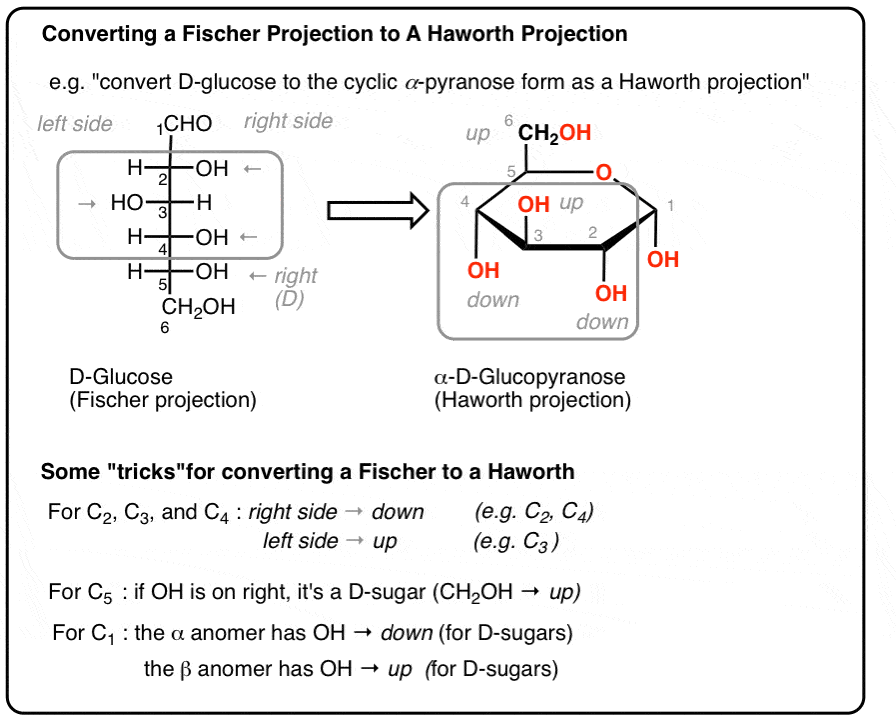
Table of Contents
- Converting A Fischer To A Haworth (The Long Way)
- The Fischer-To-Haworth Shortcut: For C2, C3, and C4, Right = Down and Left = Up
- What About C5 and C1?
- Fischer To Haworth Example 1: D-Mannose
- Example 2: L-Galactose
- Example 3: Try Going Backwards!
- What About Five-Membered Rings? (Furanoses)
- Example 4: Fructose
- Notes
- Quiz Yourself!
- (Advanced) References and Further Reading
1. Converting A Fischer to a Haworth (The Long Way)
Here’s a relatively common problem in the realm of sugar chemistry:
“Convert this (sugar) from the Fischer projection to a cyclic pyranose form as a Haworth projection.”
(the reverse question can be asked too: “convert a sugar drawn in a Haworth to an open-chain Fischer. “)
So…. how can we do this?
Well, there are a couple of tricks, and that’s what this post is about. (We’ll show how to deal with furanoses too.)
Let’s start with the example of converting D-glucose drawn in a Fischer projection to a pyranose (i.e. hexagonal) depiction in the Haworth projection – the “long way”. [The shortcut is above, BTW. If you want to skip to some practice examples, they’re below].
We’ll start by remembering what the Fischer projection really represents.
Although all the bonds in the Fischer might be drawn “flat”, it’s not meant to be understood that way! [See this earlier post on D and L sugars, for example].
By convention, the horizontal bonds on a Fischer projection actually point out of the page.
One way this was taught to me was to remember that “the arms come out to hug you“. In other words, they’re “wedged”.
The first step in converting a Fischer to a Haworth is to draw in these wedges and to number the carbons.

Next, let’s turn this molecule on its side, 90 degrees clockwise. [it must be clockwise – see Note 1]

This sets us up to form a bond between the C5-OH and the carbonyl carbon (C-1), which will make a new ring. [If this is unclear, see this earlier post on ring-chain tautomerism for more examples.]
It’s helpful to perform a bond rotation on the C5 carbon to make the stereochemistry on the ring clearer. Interchanging any three groups on a carbon does a bond rotation. [See article – How To Draw A Bond Rotation]. So we’ll make the following three “moves”:
- H → OH
- OH→ CH2OH
- CH2OH→ H
After rotation, the C5-OH is on the side rather than pointing down. In the figure below I drew it with a “dashed” bond, owing to the tetrahedral geometry on the carbon. I also drew the C2-C1 bond dashed as well.
This sets us up to draw the C5-OH attacking the carbonyl carbon, forming a new O–C1 single bond and breaking the C1-O pi bond.
After proton transfer, we now have one of two rings, which we can depict as Haworth projections!
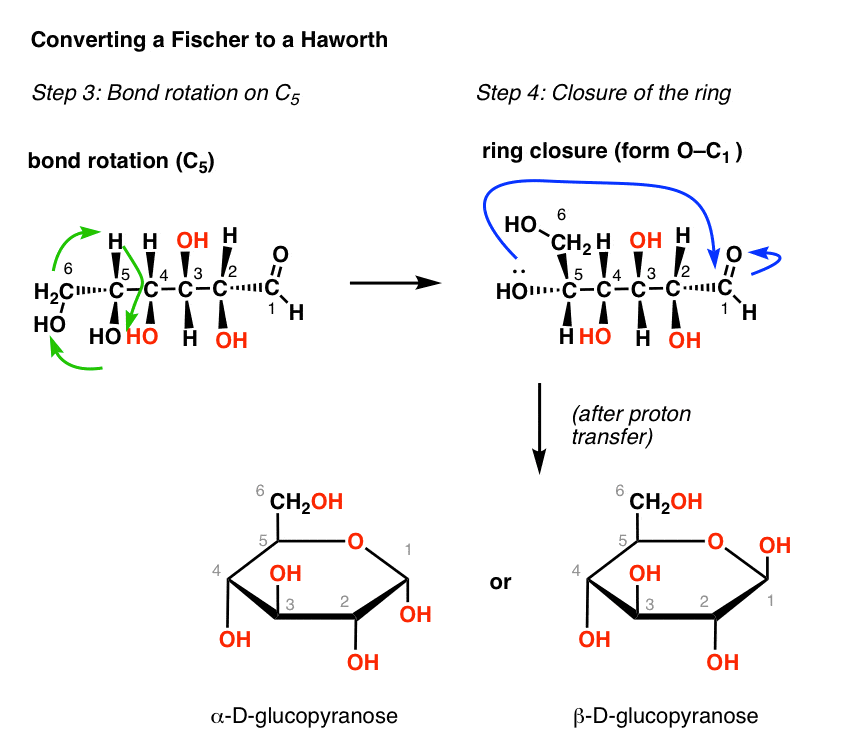
(You can imagine this as being like fastening a belt, with the OH as the “buckle” and the carbonyl carbon as the “notch” in the belt).
Notice that all the groups that were pointing “up” in our linear molecule (e.g. the C3-OH) also point “up” in the Haworth, and all the groups that point “down” in the linear molecule (e.g. C2-OH and C4-OH) point “down” in the Haworth.
(The one exception is the C1 oxygen, which can be “up” (β in this case) or “down” (α) according to which face of the carbonyl is attacked. )
Voila – there’s your conversion of a Fischer to a Haworth. If you’re keen, you can even turn the Haworth into a chair, if you start with a template and map all the substituents as we described in the last post.
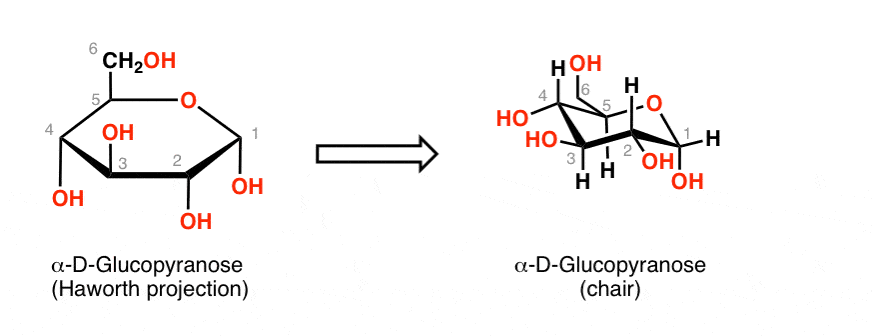
2. The Fischer-to-Haworth Shortcut: For C2, C3, and C4, Right =Down and Left =Up.
Having walked through the process the long way, let’s try to come up with a shortcut for this process.
Compare the Fischer projection of D-glucose to the final Haworth:
- C2–OH is on the right side of the Fischer and ends up on the bottom of the Haworth.
- C3–OH is on the left side of the Fischer and ends up on the top of the Haworth
- C4–OH is on the right side of the Fischer and ends up on the bottom of the Haworth
This gives us the following shortcut. If a group is on the left side of the Fischer, it will end up on the top face of the Haworth, and if it is on the right side of the Fischer, it will end up on the bottom face of the Haworth.
Right-down, left-up. (for C-2, C-3, and C-4, at least)
What about C5 and C1 ?
3. What About C5 and C1 ?
In our example the C5-OH was on the right side of the Fischer, which made it (by definition) a D-sugar. We saw that C6 (the CH2OH) ended up on the top of the Haworth, so we can make a generalization:
- for D-sugars, the C6 carbon will end up on the top of the Haworth
- for L-sugars, the C6 carbon will end up on the bottom of the Haworth.
That leaves us with C1. The hydroxyl group on C1 can end up in one of two configurations – either “up” on our Haworth, or “down”- depending on which face of the carbonyl is attacked.
The standard terminology for these two configurations at the C-1 carbon (sometimes called the “anomeric carbon“) uses the terms alpha (α) and beta (β).
In the “α” configuration, the C1-OH is on the opposite face of the ring as the C5 substituent [CH2OH in this case]. For a D-sugar, therefore, the C1-OH points down.
In the β configuration, the C1-OH is on the same face as the C5 substituent. (i.e. for a D-sugar, the C1-OH points up, as does the CH2OH attached to C5 ).

That’s the shortcut. So let’s do some examples, shall we?
4. Fischer to Haworth Example 1: D-Mannose
Mannose is a hexose where the configuration at C2 is flipped relative to glucose.
Using the shortcuts above, try converting it to a Haworth as an α-pyranose. (answer at the bottom)
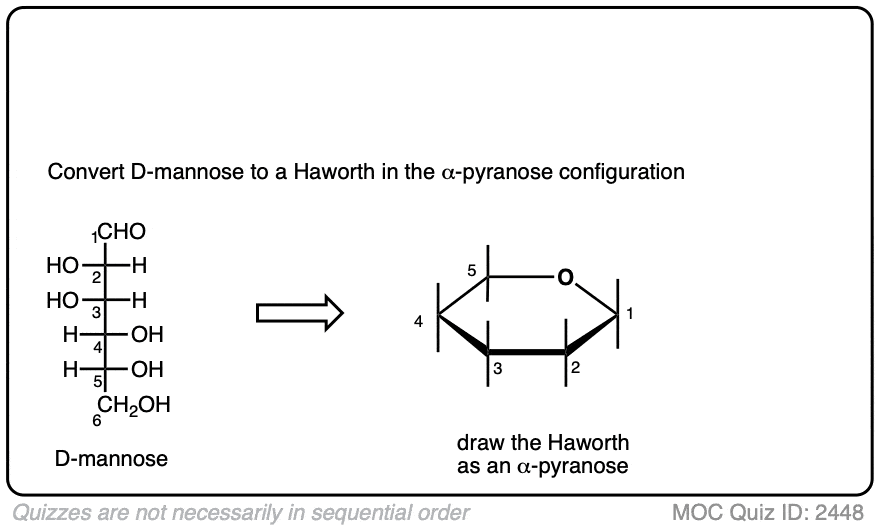 Click to Flip
Click to Flip

5. Example 2: L-Galactose
Now try a more challenging one. Starting with the structure of L-galactose, draw the Haworth as a β-pyranose.
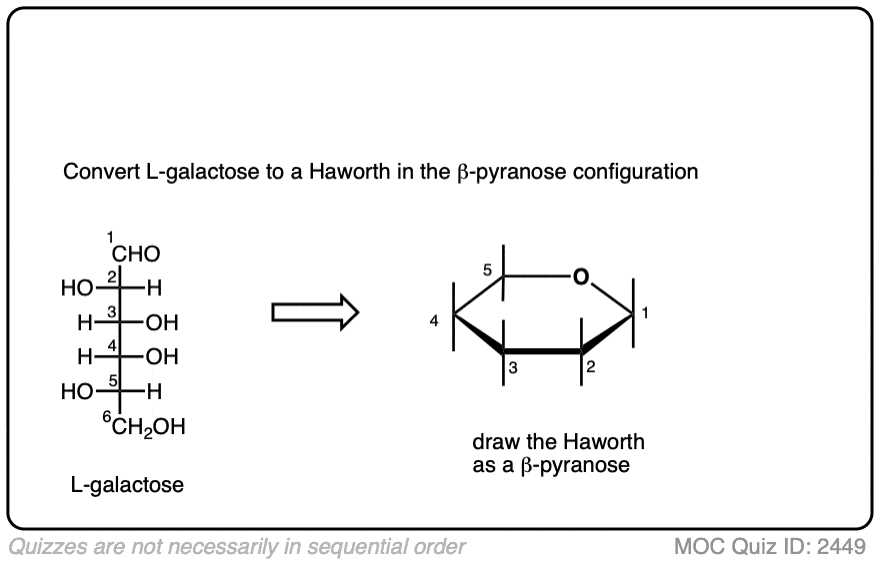 Click to Flip
Click to Flip

6. Example 3: Try going backwards!
If you know how to go from a Fischer to a Haworth, then you should be able to puzzle through going from a Haworth to a Fischer (it’s actually easier).
Try it with L-idose:
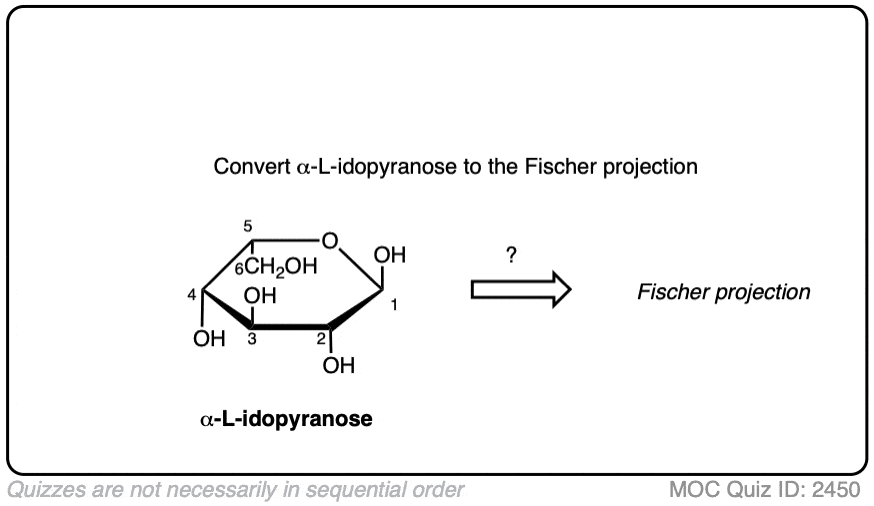 Click to Flip
Click to Flip
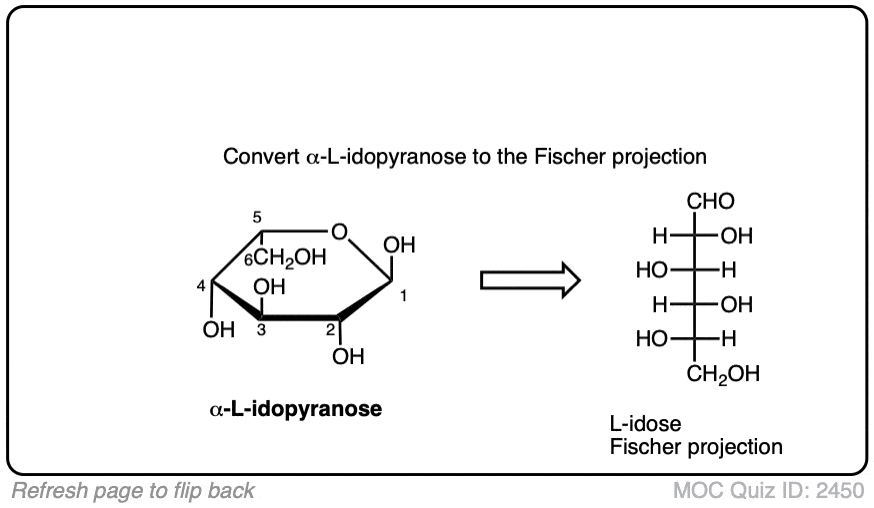
7. What About Five-Membered Rings? (Furanoses)
Haworth projections can be used for five-membered ring sugars (i.e. furanoses) too.
So how do we convert a Fischer to a five-membered Haworth?
The shortcut is essentially the same, but since the C4-OH is usually forming the ring instead of C5-OH, the mnemonic right → down and left → up only applies for the two carbons adjacent to the carbonyl (usually C2 and C3).
So if the C4-OH is forming the ring, and if it’s on the right in the Fischer (i.e. D, for a pentose), then the C5 will point up on the Haworth.
Alpha and beta in a furanose are assigned by comparing the orientation of the C1-OH with the C4 substituent (not the C5 substituent, as with a pyranose).
Here’s D-ribose converted into its α-furanose Haworth projection. [Notice that the C1-OH is on the opposite face of the molecule from the C4– substituent (CH2OH), which makes the configuration alpha (α) ]
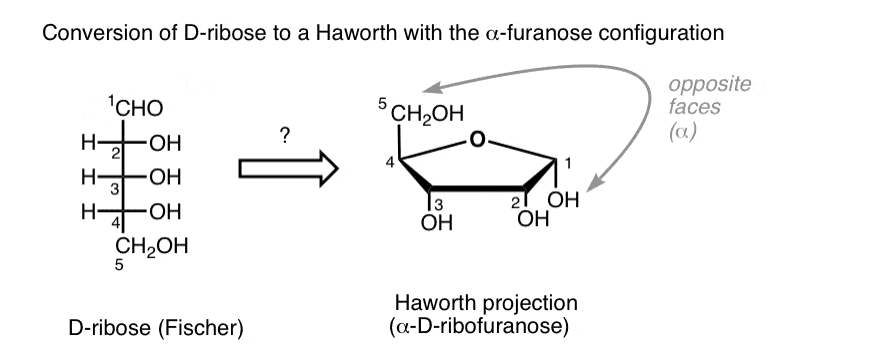
Note how the C4-OH points to the right in the Fischer and the C5 substituent (CH2OH)points up in the Haworth.
8. Example 4: Fructose
If there was a bit torturous wording in the above paragraphs using an if… then clause, that’s because I wanted the logic to be just as applicable to fructose, a six-carbon sugar (hexose) which mostly exists in the furanose form.
Fructose is a particularly interesting example because it’s a ketose, not an aldose; the ring is formed through the attack of a hydroxyl group to a ketone, not an aldehyde.
So here’s the final challenge. Given the Fischer projection, try drawing the Haworth projection ( β-furanose form) for D-fructose, below:
 Click to Flip
Click to Flip
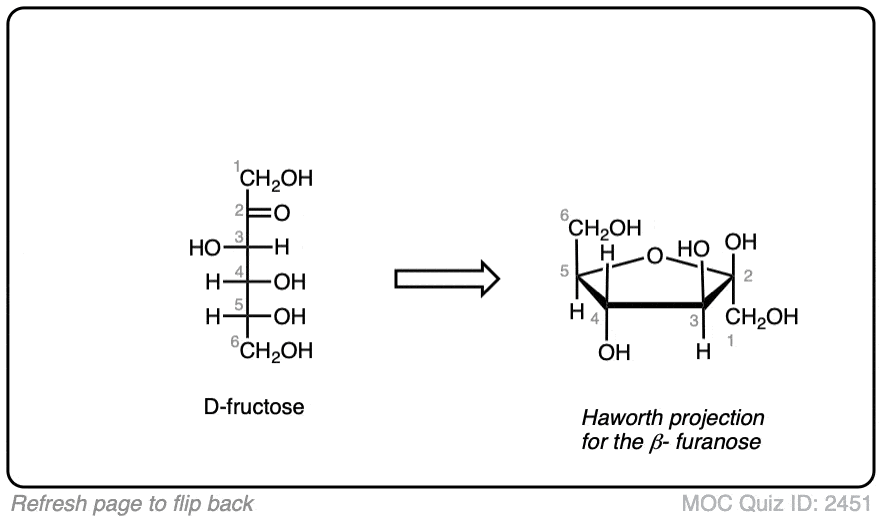
If you can do fructose without help, you’re in good shape for an exam.
Notes (and Answers)
- D-Mannose. Just like glucose, but the C-2 OH is flipped.

- L-galactose. A bit of a weird one. Note that if you remember “alpha” as the C1-OH being “up”, that only works for D-sugars.
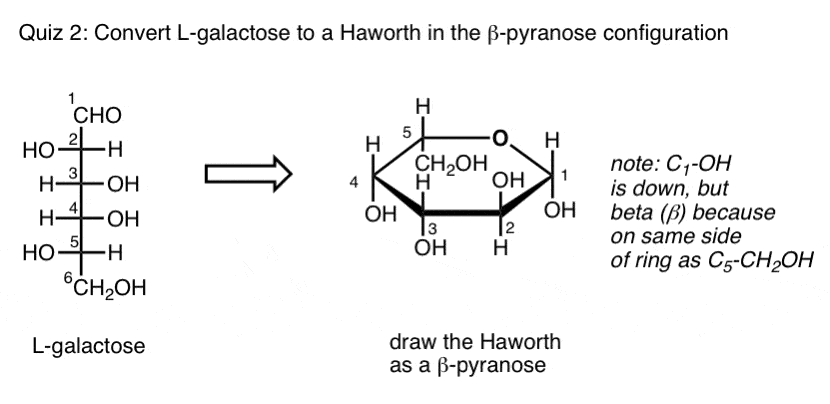
- Going to the Fischer from L-α-idopyranose

- Fructose drawn as a β-furanose:
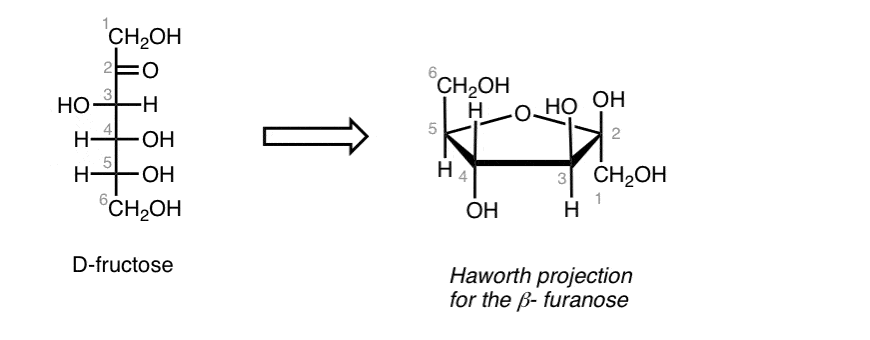
It’s beta here because the OH on the anomeric carbon (C2 in this case) is on the same face as the group on the C5 carbon (CH2OH).
Note that whatever the sugar you are given, the mental exercise of rotating the Fischer 90 degrees clockwise is useful for determining which groups will be up and which will be down.
Related Articles
- How To Determine R and S Configurations On A Fischer Projection
- Reactions of Sugars: Glycosylation and Protection
- Converting a Fischer Projection To A Haworth (And Vice Versa)
- Pyranoses and Furanoses: Ring-Chain Tautomerism In Sugars
- What is Mutarotation?
- The Big Damn Post Of Carbohydrate-Related Chemistry Definitions
- Carbohydrates Practice (MOC Membership required)
Note 1– it’s very important that it’s clockwise and not counterclockwise, otherwise it won’t be an accurate Haworth projection according to convention.
Quiz Yourself!
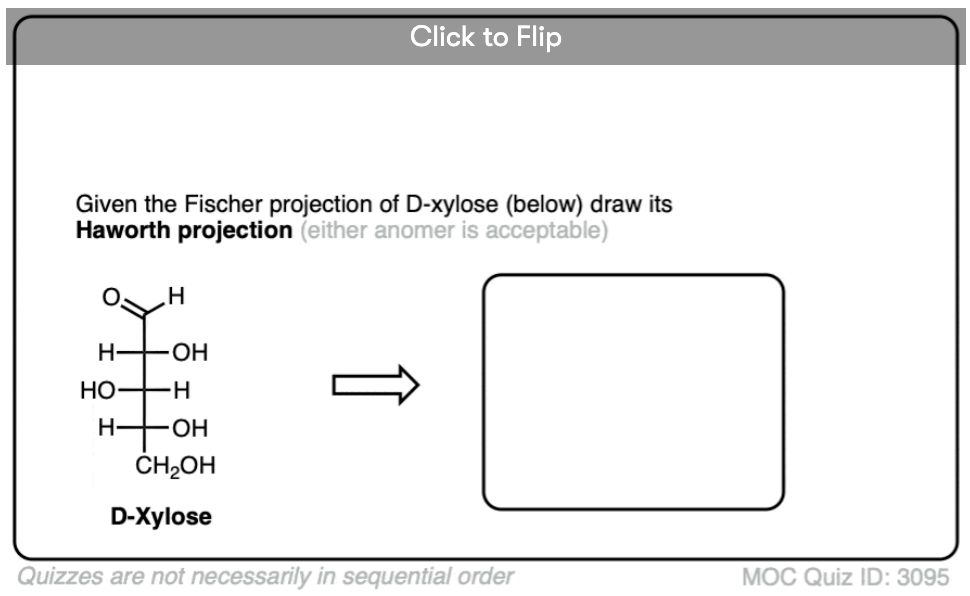
Become a MOC member to see the clickable quiz with answers on the back.
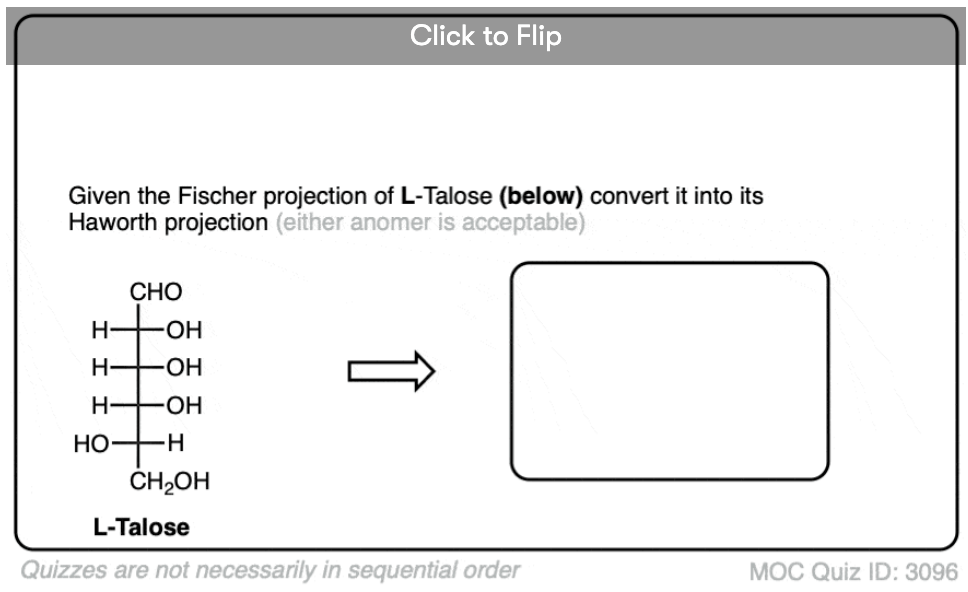
Become a MOC member to see the clickable quiz with answers on the back.
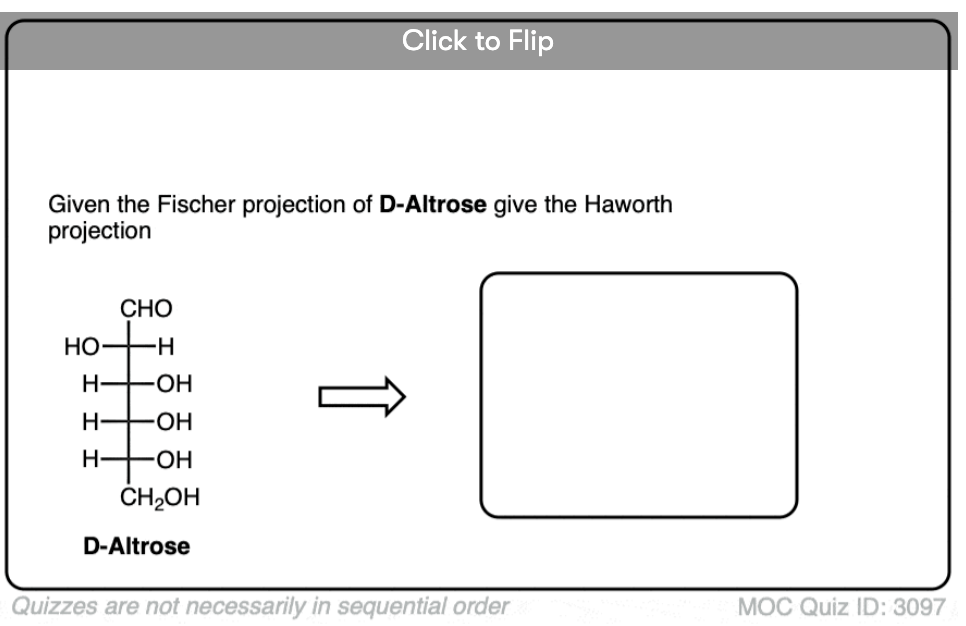
Become a MOC member to see the clickable quiz with answers on the back.

Become a MOC member to see the clickable quiz with answers on the back.

Become a MOC member to see the clickable quiz with answers on the back.
(Advanced) References and Further Reading
- The conversion of open chain structures of monosaccharides into the corresponding Haworth forms
Desmond M. S. Wheeler, Margaret M. Wheeler, and Thomas S. Wheeler
Journal of Chemical Education 1982, 59 (11), 969
DOI: 1021/ed059p969 - Simple rule for the conversion of Fischer monosaccharide projection formulas into Haworth representations
M. Argiles
Journal of Chemical Education 1986, 63 (11), 927
DOI: 10.1021/ed063p927 - A mnemonic scheme for interconverting Fischer projections of open-chain monosaccharides and Haworth projections of corresponding alpha- and beta-anomeric forms
Jonathan Mitschele
Journal of Chemical Education 1990, 67 (7), 553
DOI: 1021/ed067p553 - A New Method To Convert the Fischer Projection of a Monosaccharide to the Haworth Projection
Qing-zhi Zhang and Shen-song Zhang
Journal of Chemical Education 1999, 76 (6), 799
DOI: 1021/ed076p799 - A Simple Paper Model Illustrates How To Cyclize Monosaccharides from Fischer Projections to Haworth
Chi H. Mak
Journal of Chemical Education 2018, 95 (8), 1336-1339
DOI: 1021/acs.jchemed.7b00832Other useful references: - Rules for determining d,l configurations in Haworth structures
Jerry L. Wilson
Journal of Chemical Education 1988, 65 (9), 783
DOI: 1021/ed065p783 - Calculation and specification of the multiple chirality displayed by sugar pyranoid ring structures
Robert S. Shallenberger, Ronald E. Wrolstad, and Laurie E. Kerschner
Journal of Chemical Education 1981, 58 (8), 599
DOI: 1021/ed058p599
00 General Chemistry Review
01 Bonding, Structure, and Resonance
- How Do We Know Methane (CH4) Is Tetrahedral?
- Hybrid Orbitals and Hybridization
- How To Determine Hybridization: A Shortcut
- Orbital Hybridization And Bond Strengths
- Sigma bonds come in six varieties: Pi bonds come in one
- A Key Skill: How to Calculate Formal Charge
- The Four Intermolecular Forces and How They Affect Boiling Points
- 3 Trends That Affect Boiling Points
- How To Use Electronegativity To Determine Electron Density (and why NOT to trust formal charge)
- Introduction to Resonance
- How To Use Curved Arrows To Interchange Resonance Forms
- Evaluating Resonance Forms (1) - The Rule of Least Charges
- How To Find The Best Resonance Structure By Applying Electronegativity
- Evaluating Resonance Structures With Negative Charges
- Evaluating Resonance Structures With Positive Charge
- Exploring Resonance: Pi-Donation
- Exploring Resonance: Pi-acceptors
- In Summary: Evaluating Resonance Structures
- Drawing Resonance Structures: 3 Common Mistakes To Avoid
- How to apply electronegativity and resonance to understand reactivity
- Bond Hybridization Practice
- Structure and Bonding Practice Quizzes
- Resonance Structures Practice
02 Acid Base Reactions
- Introduction to Acid-Base Reactions
- Acid Base Reactions In Organic Chemistry
- The Stronger The Acid, The Weaker The Conjugate Base
- Walkthrough of Acid-Base Reactions (3) - Acidity Trends
- Five Key Factors That Influence Acidity
- Acid-Base Reactions: Introducing Ka and pKa
- How to Use a pKa Table
- The pKa Table Is Your Friend
- A Handy Rule of Thumb for Acid-Base Reactions
- Acid Base Reactions Are Fast
- pKa Values Span 60 Orders Of Magnitude
- How Protonation and Deprotonation Affect Reactivity
- Acid Base Practice Problems
03 Alkanes and Nomenclature
- Meet the (Most Important) Functional Groups
- Condensed Formulas: Deciphering What the Brackets Mean
- Hidden Hydrogens, Hidden Lone Pairs, Hidden Counterions
- Don't Be Futyl, Learn The Butyls
- Primary, Secondary, Tertiary, Quaternary In Organic Chemistry
- Branching, and Its Affect On Melting and Boiling Points
- The Many, Many Ways of Drawing Butane
- Wedge And Dash Convention For Tetrahedral Carbon
- Common Mistakes in Organic Chemistry: Pentavalent Carbon
- Table of Functional Group Priorities for Nomenclature
- Summary Sheet - Alkane Nomenclature
- Organic Chemistry IUPAC Nomenclature Demystified With A Simple Puzzle Piece Approach
- Boiling Point Quizzes
- Organic Chemistry Nomenclature Quizzes
04 Conformations and Cycloalkanes
- Staggered vs Eclipsed Conformations of Ethane
- Conformational Isomers of Propane
- Newman Projection of Butane (and Gauche Conformation)
- Introduction to Cycloalkanes
- Geometric Isomers In Small Rings: Cis And Trans Cycloalkanes
- Calculation of Ring Strain In Cycloalkanes
- Cycloalkanes - Ring Strain In Cyclopropane And Cyclobutane
- Cyclohexane Conformations
- Cyclohexane Chair Conformation: An Aerial Tour
- How To Draw The Cyclohexane Chair Conformation
- The Cyclohexane Chair Flip
- The Cyclohexane Chair Flip - Energy Diagram
- Substituted Cyclohexanes - Axial vs Equatorial
- Ranking The Bulkiness Of Substituents On Cyclohexanes: "A-Values"
- Cyclohexane Chair Conformation Stability: Which One Is Lower Energy?
- Fused Rings - Cis-Decalin and Trans-Decalin
- Naming Bicyclic Compounds - Fused, Bridged, and Spiro
- Bredt's Rule (And Summary of Cycloalkanes)
- Newman Projection Practice
- Cycloalkanes Practice Problems
05 A Primer On Organic Reactions
- The Most Important Question To Ask When Learning a New Reaction
- Curved Arrows (for reactions)
- Nucleophiles and Electrophiles
- The Three Classes of Nucleophiles
- Nucleophilicity vs. Basicity
- What Makes A Good Nucleophile?
- What Makes A Good Leaving Group?
- 3 Factors That Stabilize Carbocations
- Equilibrium and Energy Relationships
- 7 Factors that stabilize negative charge in organic chemistry
- 7 Factors That Stabilize Positive Charge in Organic Chemistry
- What's a Transition State?
- Hammond's Postulate
- Learning Organic Chemistry Reactions: A Checklist (PDF)
- Introduction to Oxidative Cleavage Reactions
06 Free Radical Reactions
- Bond Dissociation Energies = Homolytic Cleavage
- Free Radical Reactions
- 3 Factors That Stabilize Free Radicals
- What Factors Destabilize Free Radicals?
- Bond Strengths And Radical Stability
- Free Radical Initiation: Why Is "Light" Or "Heat" Required?
- Initiation, Propagation, Termination
- Monochlorination Products Of Propane, Pentane, And Other Alkanes
- Selectivity In Free Radical Reactions
- Selectivity in Free Radical Reactions: Bromination vs. Chlorination
- Halogenation At Tiffany's
- Allylic Bromination
- Bonus Topic: Allylic Rearrangements
- In Summary: Free Radicals
- Synthesis (2) - Reactions of Alkanes
- Free Radicals Practice Quizzes
07 Stereochemistry and Chirality
- Types of Isomers: Constitutional Isomers, Stereoisomers, Enantiomers, and Diastereomers
- How To Draw The Enantiomer Of A Chiral Molecule
- How To Draw A Bond Rotation
- Introduction to Assigning (R) and (S): The Cahn-Ingold-Prelog Rules
- Assigning Cahn-Ingold-Prelog (CIP) Priorities (2) - The Method of Dots
- Enantiomers vs Diastereomers vs The Same? Two Methods For Solving Problems
- Assigning R/S To Newman Projections (And Converting Newman To Line Diagrams)
- How To Determine R and S Configurations On A Fischer Projection
- The Meso Trap
- Optical Rotation, Optical Activity, and Specific Rotation
- Optical Purity and Enantiomeric Excess
- What's a Racemic Mixture?
- Chiral Allenes And Chiral Axes
- Stereochemistry Practice Problems and Quizzes
08 Substitution Reactions
- Nucleophilic Substitution Reactions - Introduction
- Two Types of Nucleophilic Substitution Reactions
- The SN2 Mechanism
- Why the SN2 Reaction Is Powerful
- The SN1 Mechanism
- The Conjugate Acid Is A Better Leaving Group
- Comparing the SN1 and SN2 Reactions
- Polar Protic? Polar Aprotic? Nonpolar? All About Solvents
- Steric Hindrance is Like a Fat Goalie
- Common Blind Spot: Intramolecular Reactions
- Substitution Practice - SN1
- Substitution Practice - SN2
09 Elimination Reactions
- Elimination Reactions (1): Introduction And The Key Pattern
- Elimination Reactions (2): The Zaitsev Rule
- Elimination Reactions Are Favored By Heat
- Two Elimination Reaction Patterns
- The E1 Reaction
- The E2 Mechanism
- E1 vs E2: Comparing the E1 and E2 Reactions
- Antiperiplanar Relationships: The E2 Reaction and Cyclohexane Rings
- Bulky Bases in Elimination Reactions
- Comparing the E1 vs SN1 Reactions
- Elimination (E1) Reactions With Rearrangements
- E1cB - Elimination (Unimolecular) Conjugate Base
- Elimination (E1) Practice Problems And Solutions
- Elimination (E2) Practice Problems and Solutions
10 Rearrangements
11 SN1/SN2/E1/E2 Decision
- Identifying Where Substitution and Elimination Reactions Happen
- Deciding SN1/SN2/E1/E2 (1) - The Substrate
- Deciding SN1/SN2/E1/E2 (2) - The Nucleophile/Base
- SN1 vs E1 and SN2 vs E2 : The Temperature
- Deciding SN1/SN2/E1/E2 - The Solvent
- Wrapup: The Key Factors For Determining SN1/SN2/E1/E2
- Alkyl Halide Reaction Map And Summary
- SN1 SN2 E1 E2 Practice Problems
12 Alkene Reactions
- E and Z Notation For Alkenes (+ Cis/Trans)
- Alkene Stability
- Alkene Addition Reactions: "Regioselectivity" and "Stereoselectivity" (Syn/Anti)
- Stereoselective and Stereospecific Reactions
- Hydrohalogenation of Alkenes and Markovnikov's Rule
- Hydration of Alkenes With Aqueous Acid
- Rearrangements in Alkene Addition Reactions
- Halogenation of Alkenes and Halohydrin Formation
- Oxymercuration Demercuration of Alkenes
- Hydroboration Oxidation of Alkenes
- m-CPBA (meta-chloroperoxybenzoic acid)
- OsO4 (Osmium Tetroxide) for Dihydroxylation of Alkenes
- Palladium on Carbon (Pd/C) for Catalytic Hydrogenation of Alkenes
- Cyclopropanation of Alkenes
- A Fourth Alkene Addition Pattern - Free Radical Addition
- Alkene Reactions: Ozonolysis
- Summary: Three Key Families Of Alkene Reaction Mechanisms
- Synthesis (4) - Alkene Reaction Map, Including Alkyl Halide Reactions
- Alkene Reactions Practice Problems
13 Alkyne Reactions
- Acetylides from Alkynes, And Substitution Reactions of Acetylides
- Partial Reduction of Alkynes With Lindlar's Catalyst
- Partial Reduction of Alkynes With Na/NH3 To Obtain Trans Alkenes
- Alkyne Hydroboration With "R2BH"
- Hydration and Oxymercuration of Alkynes
- Hydrohalogenation of Alkynes
- Alkyne Halogenation: Bromination, Chlorination, and Iodination of Alkynes
- Alkyne Reactions - The "Concerted" Pathway
- Alkenes To Alkynes Via Halogenation And Elimination Reactions
- Alkynes Are A Blank Canvas
- Synthesis (5) - Reactions of Alkynes
- Alkyne Reactions Practice Problems With Answers
14 Alcohols, Epoxides and Ethers
- Alcohols - Nomenclature and Properties
- Alcohols Can Act As Acids Or Bases (And Why It Matters)
- Alcohols - Acidity and Basicity
- The Williamson Ether Synthesis
- Ethers From Alkenes, Tertiary Alkyl Halides and Alkoxymercuration
- Alcohols To Ethers via Acid Catalysis
- Cleavage Of Ethers With Acid
- Epoxides - The Outlier Of The Ether Family
- Opening of Epoxides With Acid
- Epoxide Ring Opening With Base
- Making Alkyl Halides From Alcohols
- Tosylates And Mesylates
- PBr3 and SOCl2
- Elimination Reactions of Alcohols
- Elimination of Alcohols To Alkenes With POCl3
- Alcohol Oxidation: "Strong" and "Weak" Oxidants
- Demystifying The Mechanisms of Alcohol Oxidations
- Protecting Groups For Alcohols
- Thiols And Thioethers
- Calculating the oxidation state of a carbon
- Oxidation and Reduction in Organic Chemistry
- Oxidation Ladders
- SOCl2 Mechanism For Alcohols To Alkyl Halides: SN2 versus SNi
- Alcohol Reactions Roadmap (PDF)
- Alcohol Reaction Practice Problems
- Epoxide Reaction Quizzes
- Oxidation and Reduction Practice Quizzes
15 Organometallics
- What's An Organometallic?
- Formation of Grignard and Organolithium Reagents
- Organometallics Are Strong Bases
- Reactions of Grignard Reagents
- Protecting Groups In Grignard Reactions
- Synthesis Problems Involving Grignard Reagents
- Grignard Reactions And Synthesis (2)
- Organocuprates (Gilman Reagents): How They're Made
- Gilman Reagents (Organocuprates): What They're Used For
- The Heck, Suzuki, and Olefin Metathesis Reactions (And Why They Don't Belong In Most Introductory Organic Chemistry Courses)
- Reaction Map: Reactions of Organometallics
- Grignard Practice Problems
16 Spectroscopy
- Degrees of Unsaturation (or IHD, Index of Hydrogen Deficiency)
- Conjugation And Color (+ How Bleach Works)
- Introduction To UV-Vis Spectroscopy
- UV-Vis Spectroscopy: Absorbance of Carbonyls
- UV-Vis Spectroscopy: Practice Questions
- Bond Vibrations, Infrared Spectroscopy, and the "Ball and Spring" Model
- Infrared Spectroscopy: A Quick Primer On Interpreting Spectra
- IR Spectroscopy: 4 Practice Problems
- 1H NMR: How Many Signals?
- Homotopic, Enantiotopic, Diastereotopic
- Diastereotopic Protons in 1H NMR Spectroscopy: Examples
- 13-C NMR - How Many Signals
- Liquid Gold: Pheromones In Doe Urine
- Natural Product Isolation (1) - Extraction
- Natural Product Isolation (2) - Purification Techniques, An Overview
- Structure Determination Case Study: Deer Tarsal Gland Pheromone
17 Dienes and MO Theory
- What To Expect In Organic Chemistry 2
- Are these molecules conjugated?
- Conjugation And Resonance In Organic Chemistry
- Bonding And Antibonding Pi Orbitals
- Molecular Orbitals of The Allyl Cation, Allyl Radical, and Allyl Anion
- Pi Molecular Orbitals of Butadiene
- Reactions of Dienes: 1,2 and 1,4 Addition
- Thermodynamic and Kinetic Products
- More On 1,2 and 1,4 Additions To Dienes
- s-cis and s-trans
- The Diels-Alder Reaction
- Cyclic Dienes and Dienophiles in the Diels-Alder Reaction
- Stereochemistry of the Diels-Alder Reaction
- Exo vs Endo Products In The Diels Alder: How To Tell Them Apart
- HOMO and LUMO In the Diels Alder Reaction
- Why Are Endo vs Exo Products Favored in the Diels-Alder Reaction?
- Diels-Alder Reaction: Kinetic and Thermodynamic Control
- The Retro Diels-Alder Reaction
- The Intramolecular Diels Alder Reaction
- Regiochemistry In The Diels-Alder Reaction
- The Cope and Claisen Rearrangements
- Electrocyclic Reactions
- Electrocyclic Ring Opening And Closure (2) - Six (or Eight) Pi Electrons
- Diels Alder Practice Problems
- Molecular Orbital Theory Practice
18 Aromaticity
- Introduction To Aromaticity
- Rules For Aromaticity
- Huckel's Rule: What Does 4n+2 Mean?
- Aromatic, Non-Aromatic, or Antiaromatic? Some Practice Problems
- Antiaromatic Compounds and Antiaromaticity
- The Pi Molecular Orbitals of Benzene
- The Pi Molecular Orbitals of Cyclobutadiene
- Frost Circles
- Aromaticity Practice Quizzes
19 Reactions of Aromatic Molecules
- Electrophilic Aromatic Substitution: Introduction
- Activating and Deactivating Groups In Electrophilic Aromatic Substitution
- Electrophilic Aromatic Substitution - The Mechanism
- Ortho-, Para- and Meta- Directors in Electrophilic Aromatic Substitution
- Understanding Ortho, Para, and Meta Directors
- Why are halogens ortho- para- directors?
- Disubstituted Benzenes: The Strongest Electron-Donor "Wins"
- Electrophilic Aromatic Substitutions (1) - Halogenation of Benzene
- Electrophilic Aromatic Substitutions (2) - Nitration and Sulfonation
- EAS Reactions (3) - Friedel-Crafts Acylation and Friedel-Crafts Alkylation
- Intramolecular Friedel-Crafts Reactions
- Nucleophilic Aromatic Substitution (NAS)
- Nucleophilic Aromatic Substitution (2) - The Benzyne Mechanism
- Reactions on the "Benzylic" Carbon: Bromination And Oxidation
- The Wolff-Kishner, Clemmensen, And Other Carbonyl Reductions
- More Reactions on the Aromatic Sidechain: Reduction of Nitro Groups and the Baeyer Villiger
- Aromatic Synthesis (1) - "Order Of Operations"
- Synthesis of Benzene Derivatives (2) - Polarity Reversal
- Aromatic Synthesis (3) - Sulfonyl Blocking Groups
- Birch Reduction
- Synthesis (7): Reaction Map of Benzene and Related Aromatic Compounds
- Aromatic Reactions and Synthesis Practice
- Electrophilic Aromatic Substitution Practice Problems
20 Aldehydes and Ketones
- What's The Alpha Carbon In Carbonyl Compounds?
- Nucleophilic Addition To Carbonyls
- Aldehydes and Ketones: 14 Reactions With The Same Mechanism
- Sodium Borohydride (NaBH4) Reduction of Aldehydes and Ketones
- Grignard Reagents For Addition To Aldehydes and Ketones
- Wittig Reaction
- Hydrates, Hemiacetals, and Acetals
- Imines - Properties, Formation, Reactions, and Mechanisms
- All About Enamines
- Breaking Down Carbonyl Reaction Mechanisms: Reactions of Anionic Nucleophiles (Part 2)
- Aldehydes Ketones Reaction Practice
21 Carboxylic Acid Derivatives
- Nucleophilic Acyl Substitution (With Negatively Charged Nucleophiles)
- Addition-Elimination Mechanisms With Neutral Nucleophiles (Including Acid Catalysis)
- Basic Hydrolysis of Esters - Saponification
- Transesterification
- Proton Transfer
- Fischer Esterification - Carboxylic Acid to Ester Under Acidic Conditions
- Lithium Aluminum Hydride (LiAlH4) For Reduction of Carboxylic Acid Derivatives
- LiAlH[Ot-Bu]3 For The Reduction of Acid Halides To Aldehydes
- Di-isobutyl Aluminum Hydride (DIBAL) For The Partial Reduction of Esters and Nitriles
- Amide Hydrolysis
- Thionyl Chloride (SOCl2) And Conversion of Carboxylic Acids to Acid Halides
- Diazomethane (CH2N2)
- Carbonyl Chemistry: Learn Six Mechanisms For the Price Of One
- Making Music With Mechanisms (PADPED)
- Carboxylic Acid Derivatives Practice Questions
22 Enols and Enolates
- Keto-Enol Tautomerism
- Enolates - Formation, Stability, and Simple Reactions
- Kinetic Versus Thermodynamic Enolates
- Aldol Addition and Condensation Reactions
- Reactions of Enols - Acid-Catalyzed Aldol, Halogenation, and Mannich Reactions
- Claisen Condensation and Dieckmann Condensation
- Decarboxylation
- The Malonic Ester and Acetoacetic Ester Synthesis
- The Michael Addition Reaction and Conjugate Addition
- The Robinson Annulation
- Haloform Reaction
- The Hell–Volhard–Zelinsky Reaction
- Enols and Enolates Practice Quizzes
23 Amines
- The Amide Functional Group: Properties, Synthesis, and Nomenclature
- Basicity of Amines And pKaH
- 5 Key Basicity Trends of Amines
- The Mesomeric Effect And Aromatic Amines
- Nucleophilicity of Amines
- Alkylation of Amines (Sucks!)
- Reductive Amination
- The Gabriel Synthesis
- Some Reactions of Azides
- The Hofmann Elimination
- The Hofmann and Curtius Rearrangements
- The Cope Elimination
- Protecting Groups for Amines - Carbamates
- The Strecker Synthesis of Amino Acids
- Introduction to Peptide Synthesis
- Reactions of Diazonium Salts: Sandmeyer and Related Reactions
- Amine Practice Questions
24 Carbohydrates
- D and L Notation For Sugars
- Pyranoses and Furanoses: Ring-Chain Tautomerism In Sugars
- What is Mutarotation?
- Reducing Sugars
- The Big Damn Post Of Carbohydrate-Related Chemistry Definitions
- The Haworth Projection
- Converting a Fischer Projection To A Haworth (And Vice Versa)
- Reactions of Sugars: Glycosylation and Protection
- The Ruff Degradation and Kiliani-Fischer Synthesis
- Isoelectric Points of Amino Acids (and How To Calculate Them)
- Carbohydrates Practice
- Amino Acid Quizzes
25 Fun and Miscellaneous
- A Gallery of Some Interesting Molecules From Nature
- Screw Organic Chemistry, I'm Just Going To Write About Cats
- On Cats, Part 1: Conformations and Configurations
- On Cats, Part 2: Cat Line Diagrams
- On Cats, Part 4: Enantiocats
- On Cats, Part 6: Stereocenters
- Organic Chemistry Is Shit
- The Organic Chemistry Behind "The Pill"
- Maybe they should call them, "Formal Wins" ?
- Why Do Organic Chemists Use Kilocalories?
- The Principle of Least Effort
- Organic Chemistry GIFS - Resonance Forms
- Reproducibility In Organic Chemistry
- What Holds The Nucleus Together?
- How Reactions Are Like Music
- Organic Chemistry and the New MCAT
26 Organic Chemistry Tips and Tricks
- Common Mistakes: Formal Charges Can Mislead
- Partial Charges Give Clues About Electron Flow
- Draw The Ugly Version First
- Organic Chemistry Study Tips: Learn the Trends
- The 8 Types of Arrows In Organic Chemistry, Explained
- Top 10 Skills To Master Before An Organic Chemistry 2 Final
- Common Mistakes with Carbonyls: Carboxylic Acids... Are Acids!
- Planning Organic Synthesis With "Reaction Maps"
- Alkene Addition Pattern #1: The "Carbocation Pathway"
- Alkene Addition Pattern #2: The "Three-Membered Ring" Pathway
- Alkene Addition Pattern #3: The "Concerted" Pathway
- Number Your Carbons!
- The 4 Major Classes of Reactions in Org 1
- How (and why) electrons flow
- Grossman's Rule
- Three Exam Tips
- A 3-Step Method For Thinking Through Synthesis Problems
- Putting It Together
- Putting Diels-Alder Products in Perspective
- The Ups and Downs of Cyclohexanes
- The Most Annoying Exceptions in Org 1 (Part 1)
- The Most Annoying Exceptions in Org 1 (Part 2)
- The Marriage May Be Bad, But the Divorce Still Costs Money
- 9 Nomenclature Conventions To Know
- Nucleophile attacks Electrophile
27 Case Studies of Successful O-Chem Students
- Success Stories: How Corina Got The The "Hard" Professor - And Got An A+ Anyway
- How Helena Aced Organic Chemistry
- From a "Drop" To B+ in Org 2 – How A Hard Working Student Turned It Around
- How Serge Aced Organic Chemistry
- Success Stories: How Zach Aced Organic Chemistry 1
- Success Stories: How Kari Went From C– to B+
- How Esther Bounced Back From a "C" To Get A's In Organic Chemistry 1 And 2
- How Tyrell Got The Highest Grade In Her Organic Chemistry Course
- This Is Why Students Use Flashcards
- Success Stories: How Stu Aced Organic Chemistry
- How John Pulled Up His Organic Chemistry Exam Grades
- Success Stories: How Nathan Aced Organic Chemistry (Without It Taking Over His Life)
- How Chris Aced Org 1 and Org 2
- Interview: How Jay Got an A+ In Organic Chemistry
- How to Do Well in Organic Chemistry: One Student's Advice
- "America's Top TA" Shares His Secrets For Teaching O-Chem
- "Organic Chemistry Is Like..." - A Few Metaphors
- How To Do Well In Organic Chemistry: Advice From A Tutor
- Guest post: "I went from being afraid of tests to actually looking forward to them".
Thank you very much
Great work. Thank you.
I have not seen this type of easiest explation.
galactose configuration is wrong I suppose.
D-galactose can be obtained by flipping configuration at C-4 for D-glucose. Now to convert D to L, configuration at C-5 is flipped too. This results in a structure, where -OH groups point to the left on C-3, C-4 and C-5
Thank you. It is easy to explain.
Can you tell me which software did you use to draw the Haworth projection? I’ve been using ChemDraw 21.0, but I found the template nowhere. Thank you!
It’s under Conformers
I like the way it’s represented ..it’s now made simple
Spent two hours trying to fold lines in my head and failing, then I remembered I was a member of this website, and in a paragraph, everything’s clear. Thank you very much, you did a very good job and saved me a lot of time !
I am so glad you found it helpful, Alexandre!
Ca you give me an explaination why fischer projection to haworth structure forms?
Cathy – I’m not sure I understand your question – Fischer and Haworth projections are just different ways of drawing the same molecule.
The Fischer projection of L-galactose in Example 2 is incorrect.
For L-galactose? Are you sure? It’s the opposite of D-galactose, shown here… https://en.wikipedia.org/wiki/Galactose
Oh! now l know how to change from Fischer projection to Haworth projection.
Thank you!????
Glad you found it helpful, Kal!
This comment is regarding the note in the above article that clarifies why the molecule must be rotated clockwise. I think that mentioning this – rotating the molecule anticlockwise would give a Haworth projection with the C1 carbon to the left of the -O- atom and that is why it is not an accurate Haworth representation – would make this article clearer. I say this is because I found myself confused at this very statement before I realized why it was so and I’m sure there would be someone else with the same doubt.
Used your resources in high school, in undergrad, and now for MCAT studying.
Really… those institutions that didn’t offer you a faculty position made a HUGE mistake.
This is simply awesome, thank you for this useful resource!